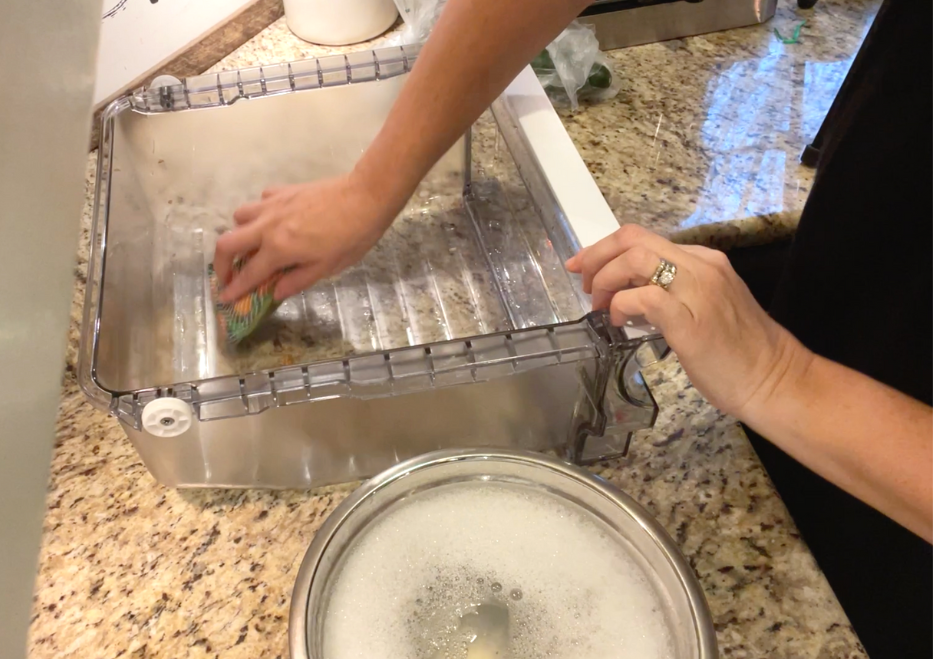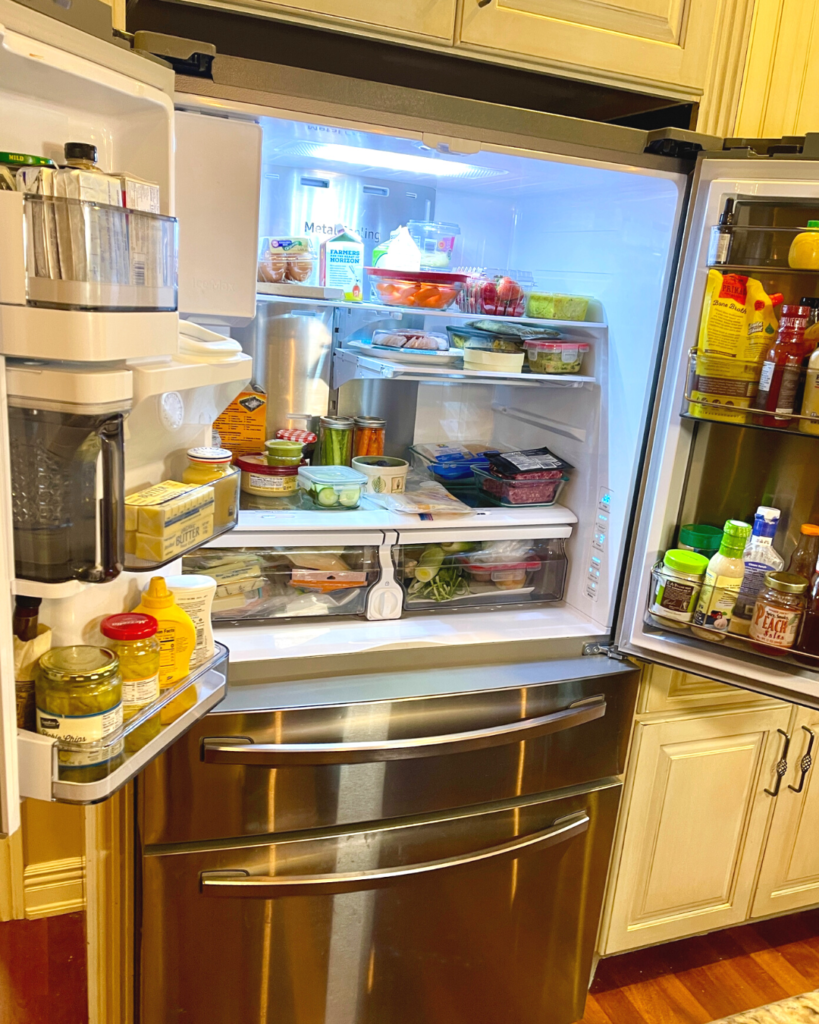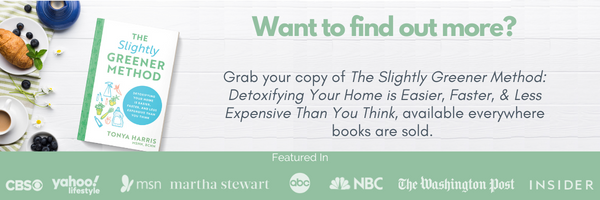Did you know there is a National Clean out Your Refrigerator Day?
This day was created by Whirlpool Home Appliances in 1999 to encourage people to clean out their refrigerator before the upcoming holidays.
And while the national day is celebrated November 15th, anytime really is a good time to clean out your fridge! Not only will it help get rid of pesky leftovers, but it helps place items for optimal safe food storage. Plus, have you ever wondered how long you can safely keep those leftovers?
A couple years ago, I did a TV interview on WFLA in Tampa on Bloom TV for National Clean Out Your Refrigerator Day. I cleaned and organized the heck out of it! I like to keep it clean, but come on, a TV interview with my everyday lived-in fridge? 😂
And does it still look like the video? Oh, no. Not even close. We’re a family of 5, so it’s a ongoing challenge to keep it clean and organized! I think the fridge looked like that video for 2 days – tops.
With the holidays coming up, I’m going to do a fridge clean-out, and thought I’d share my favorite tips.
Because not only does it look great to have a clean fridge, but it feels great. It’s also much easier to clean when you have a (somewhat) regular clean-out schedule.
AND it can save money by being able to easily see everything in your fridge, decreasing the chances of buying something you already have because you didn’t see it buried deep in the back of the fridge. Or worse yet – having something go bad before you could use it.
While cleaning out the fridge is usually a tedious task, there are some simple ways to make cleaning your fridge easy.
How to Clean out Your Fridge
The first thing you’ll want to have is an empty countertop space to put the items, or a small cooler to place items in while you clean.
I like to do one shelf at a time to make it more doable. Plus if you have to stop in the middle of cleaning for some reason, you won’t have as much to quickly put away.
What you’ll do is use the countertop to sort the items into 3 groups:
– Items you use everyday.
– Items you use less frequently.
– Expired items to throw away. Toss these.
This is also a good time to write down those items that were expired or low that you need to replenish. When you’re ready to buy new ones, buy a safer brand of the products you use most. (If you need help with this, grab my book, The Slightly Greener Method!) And if you want some tips to save money on those organic and/or safer products, I talked about those in episode 2 of the podcast.
Next, it’s time to tackle those shelves. Start on the top shelf, since wiping away crumbs and debris can make their way to lower shelves.
Then vacuum or wipe up any crumbs or debris. Wash the shelves with a soft sponge or washcloth dipped in warm, soapy water (not hot, if the shelves are still in the fridge; hot water on a cold shelf can crack it). I like to use liquid castile soap by Vermont Soap.
Empty drawers completely and vacuum out any crumbs. Remove them to  clean out and underneath.
clean out and underneath.
DIY Grime-Busting Shelf Cleaner
For stuck on-messes, spray the area with a Castile-soap based cleaner and let it sit for several minutes, then wipe away. Or you can also make a paste to gently scrub the grimy area.
- Combine approximately 2 tablespoons of baking soda and 1 teaspoon of water in a small bowl to make a paste.
- Spread the paste over the grimy areas, then lightly spray vinegar over the paste to make it fizz and bubble. Scrub gently with a soft sponge, so you don’t scratch the surface.
- For stubborn areas, let the scrub dry completely, then spray lightly with vinegar before scrubbing it away.
Organizing the Refrigerator
Now that you’ve sorted the items and have tossed the expired/unwanted items, it’s time to organize and put everything back in!
There are lots of great Pinterest-y ideas out there for organizing your fridge, but I’m not one for buying all the plastic containers to organize (but if you are, definitely go for it!). I always feel like they look beautiful when they’re fully stocked, but once items start to dwindle the unbalanced look drives me a little crazy. Maybe that’s just me?
But that’s just my opinion, and I am definitely not against a couple here and there to help organize sauces, etc. if needed. Do what you’re comfortable with, and if you want to do a full-on Pinterest-y fridge, that’s awesome and I will secretly be jealous!
Ok back to putting everything back in. To start, place items you use less  frequently toward the back of the fridge. You should be able to see them better now that you have more room. Items that you use daily or more often should be toward the front of the fridge.
frequently toward the back of the fridge. You should be able to see them better now that you have more room. Items that you use daily or more often should be toward the front of the fridge.
Where to Store Meat and Eggs in the Fridge
- Raw meats should be stored in containers or sealed plastic bags to avoid cross-contamination and possible leakage. Place them on the bottom shelf to avoid contamination by any drippings.
- Store items like meat, milk, and eggs in the actual compartment of the refrigerator instead of in the doors. The main compartment is the coldest area of the fridge, and the doors are the warmest. The doors should only be used for things like condiments and dressings, etc (even if it has that cool egg holder!).
- Don’t over-fill the fridge. Air needs to circulate in order for the refrigerator to cool efficiently, so don’t try to fit everything and shove it against the back of the fridge. This overworks your fridge and can lead to it not getting cool enough – not to mention causing problems and more wear and tear.
How Long Can Meat be Stored
While we’re on the topic of cleaning out your fridge, here are some other things to keep in mind – when you’re wondering whether to keep or toss foods, here are some general guidelines, according to the USDA:
Meats like beef, veal, pork roasts, steaks and chops can be kept 3 to 5 days in the fridge before cooking or freezing.
For fresh chicken, ground meat, and ground poultry, turkey, the USDA recommends refrigerating and using them within 1 to 2 days before either cooking or freezing.
After cooking, meats, poultry, and seafood can be safely stored in the refrigerator for 3 to 4 days.
Use eggs within 3-5 weeks after purchase. According to the FDA, eggs can still be used within that time frame even if the “sell by” date has passed (as long as you purchase them by that date).
How Long to Safely Store Leftovers
To avoid food poisoning, the Mayo Clinic recommends refrigerating leftovers within 2 hours and eating them within 3-4 days.
A great resource for what labels mean (like “best by” and “sell by,” etc.) and how long to store even more foods, is the “Food Facts” guide from the FDA. The FoodKeeper app for Apple and Android are also helpful.
How Often You Should Clean Out Your Fridge
Your refrigerator should be cleaned with a deeper clean like this every 3-4 months. Cleaning out expired items regularly and leftovers weekly will really cut down on the amount of time those deeper cleans will take.
To keep up on the all the hard work you just did, set a timer reminder on your phone each week the day or night before your garbage gets picked up. This makes it easy to remember to clean out any leftovers that weren’t eaten, or any expired produce, etc. This also makes it much quicker to do those deeper cleans every couple of months!

